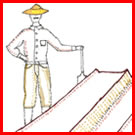Subsistence farmers suffer not only from depleted soils but from challenges with water: too little water, too much water, and erosion from water. This field guide looks at different ways of managing water and conserving soil by developing barriers on farm fields for stopping the flow of water so that it can percolate into the soil and build up soil moisture. The barriers also reduce the loss of soil from erosion.
Barriers to Water Movement
On sloping farm fields, creating barriers reduces the speed of water movement so that it can be absorbed into the soil rather than simply running off the land. These barriers also catch topsoil that the water carries preventing the loss of this valuable resource and offer the added benefit of creating level planting areas behind the barriers as the soil accumulates. Barriers can be terraces, stone or earth walls called bunds, or living barriers such as hedges and grass strips.
Building terraces and stone retaining walls can be very labor intensive. Less formal constructions such as soil bunds, hedgerows or rows of grass can be less labor-intensive and potentially more attractive to farmers. Construction can be spread out over several years.
One thing that all barriers have in common is that they run horizontally along a level contour across the falling slope of a field. An A-frame leveling device is used to determine the level contour lines which are marked with stakes or with stones.
Here are four techniques for farmers to consider. The technique chosen by each individual farmer will be based upon how steeply a farmer’s field slopes, how big their field is, whether they are in a high rainfall or low rainfall region, and how much time they have available for investing in the technique.
Contour Ridges.
Ridges with furrows on the uphill side are formed approximately 1.5m to 2m apart. This 2m area is the catchment area for rainwater. The ridges are only 15 to 20 cm high—simply high enough to contain the run off—which collects in the furrow. Crops with higher water requirements can be planted close to the side of the furrow. Contour ridges represent the least time investment of these four techniques and can be developed, maintained and improved during preparation for each planting season.
| Soil Bunds | |
 |
Soil bunds are a method for both containing water and reducing erosion using on-site materials. After marking the horizontal contour line on the sloping field, a ditch 60 cm deep and 60 cm wide is dug. The soil is placed on the downhill side of the ditch creating the soil wall. The base of the wall is typically twice as wide as the wall is high. The soil is well compacted by hand. |
Soil bunds are placed from between 5m apart on steep land to 20m apart on more gently sloping land. To determine spacing between the bunds, one rule of thumb is that the top of one bund is level with the base of the adjacent uphill bund. However farmer preferences and the size of the farmer’s field are other determinants.
Fodder grasses, trees and crops are planted on the bund to stabilize it. Water collects in the ditch during rainstorms and can slowly percolate into the soil increasing soil moisture. As rainwater erodes soil uphill of the bund, the soil will accumulate above the bund and begin creating an increasingly level planting strip. Soil bunds will need annual maintenance—and will need to be checked after heavy rainfall and breaches repaired immediately.
Hedgerows.
Hedgerows can also be planted along the contour lines of a hillside—in similar spacing as soil bunds depending on the steepness of the slope of the field. Hedges are usually chosen from nitrogen fixing plants, and from plants that when pruned can be used as fodder for farm animals. Initially, these cuttings can be laid at the base of the hedges on the uphill side to trap eroded topsoil. After two or three years, sufficient topsoil will have accumulated to form a terrace uphill of the hedgerow. Hedgerows represent substantially less time investment than soil bunds—and use less space making more land available for planting.
Vetiver Grass Strips.
An inexpensive alternative, vetiver grass can be planted along the contour line of a sloping field to prevent the loss of topsoil, and to reduce the rate at which water runs downhill enhancing infiltration. Topsoil builds up on the uphill side and over time creates level planting areas. Grass strips represent substantially less time investment than soil bunds—and use less space. Grass strips need to be maintained over time to keep them from encroaching into the cropping areas. Grass trimmings can be used as fodder. Vetiver grass is very popular, but check with farmers for local favorites.
Conclusion.
Upon completion of this workshop discuss with the farmers which technique would be best suited for them. Then plan a second more specialized training workshop for that specific technique.